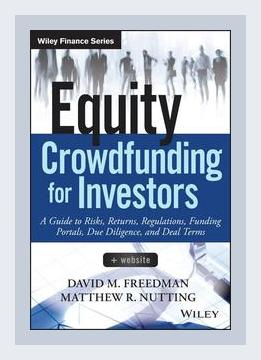Entrepreneurship and StartupsFunding and Investment
Introduction
Equity Crowdfunding for Investors by David M. Freedman and Matthew R. Nutting provides a comprehensive guide through the multifaceted world of equity crowdfunding. This book is particularly valuable for understanding the risks, returns, regulations, funding portals, due diligence, and deal terms associated with this burgeoning field. The authors combine their extensive experience in finance to offer actionable advice to potential investors.
1. The Evolution of Equity Crowdfunding
Summary: The book begins by tracing the history and regulatory evolution of equity crowdfunding. Initially part of the JOBS Act in 2012, it aimed to create opportunities for small investors to back startups.
Action: Review the historical context and regulatory environment of equity crowdfunding to understand its foundations.
Example: The authors describe how the JOBS Act’s Title III paved the way for non-accredited investors to engage in equity crowdfunding, highlighting legislative milestones.
2. Risks Associated with Equity Crowdfunding
Summary: The authors outline several risks, including financial loss, liquidity risk, and lack of control over the company.
Action: Before making an investment, perform a risk assessment considering your financial position and risk tolerance.
Example: The authors explain, “A majority of startups fail within the first few years,” underlining the significant risk of financial loss. They advise, “Invest only what you can afford to lose.”
3. Potential Returns
Summary: While emphasizing the high-risk nature, the book illustrates the potential for substantial returns if an investment succeeds.
Action: Balance your portfolio with both high-risk/high-reward crowdfunding investments and more stable assets.
Example: Freedman and Nutting cite the example of Oculus Rift, which began as a crowdfunded project and was later acquired by Facebook for $2 billion. They demonstrate the potential upside for early investors.
4. Regulatory Framework
Summary: The authors delve into the complex regulatory landscape governing equity crowdfunding, emphasizing compliance and due diligence.
Action: Familiarize yourself with current regulations and ensure any investment platform is fully compliant.
Example: Title III of the JOBS Act requires companies to disclose financial statements audited by a CPA when raising over $500,000. Understanding these disclosures can prevent legal pitfalls.
5. Choosing the Right Funding Portal
Summary: Not all platforms are created equal. The book provides criteria for evaluating crowdfunding portals.
Action: Evaluate funding portals based on their regulatory compliance, reputation, fee structure, and vetting process.
Example: The authors praise platforms like AngelList and SeedInvest for their stringent vetting processes, which they believe offer safer investment vehicles.
6. Conducting Due Diligence
Summary: Due diligence is crucial in mitigating risks. The book guides investors through assessing the viability of startups.
Action: Conduct thorough online and offline research on potential investments, including company background, market positioning, and financial health.
Example: Freedman and Nutting recommend utilizing resources like Crunchbase and LinkedIn to verify information about the company’s founders and their operational history.
7. Understanding Deal Terms
Summary: The authors break down critical terms in a crowdfunding deal, such as equity stakes, valuation, and investor rights.
Action: Scrutinize the terms of investment agreements to ensure they align with your expectations and protect your interests.
Example: They illustrate a typical term sheet, discussing provisions like liquidation preferences, anti-dilution rights, and voting rights. For instance, “A 2x liquidation preference means you get twice your investment back before common shareholders receive anything.”
8. Managing Your Crowdfunding Portfolio
Summary: Portfolio management is discussed, emphasizing the importance of diversification and ongoing monitoring.
Action: Diversify your investments across multiple startups and sectors to spread risk.
Example: The authors suggest, “Invest in at least 10-15 different startups to increase the chances that one becomes highly successful, offsetting any losses.”
9. Post-Investment Responsibilities
Summary: Post-investment strategies include staying informed about the company’s progress and understanding your legal rights as an investor.
Action: Maintain regular communication with the company and stay updated with their financial reports and strategic decisions.
Example: Freedman and Nutting cite instances where active angel investors provide mentorship and resources to startups, which can increase the likelihood of success.
10. Case Studies and Real-world Examples
Summary: The book is rich with case studies and real-world examples that illustrate both successes and failures in equity crowdfunding.
Action: Analyze these case studies to glean insights and strategies that can be applied to your investment decisions.
Example: The authors discuss the case of Failure, Inc., a company that looked promising but failed due to market miscalculations, lack of funds, and poor management. This underscores the importance of understanding all facets of the business before investing.
Conclusion
The authors conclude by reiterating the significance of approaching equity crowdfunding with a well-informed and cautious mindset. They encourage continuous learning, ongoing due diligence, and maintaining realistic expectations.
Final Note
Summary: Freedman and Nutting advise treating equity crowdfunding as one part of a diversified investment strategy rather than a primary investment vehicle.
Action: Use equity crowdfunding to complement traditional investments, not replace them.
Example: They emphasize setting aside a small percentage of one’s portfolio for equity crowdfunding, akin to the principle of venture capital where only a fraction of investments yield significant returns.
This structured approach offered by Equity Crowdfunding for Investors ensures that readers are not only aware of the opportunities but are also prepared for the challenges associated with this form of investment. The book’s combination of theoretical knowledge and practical advice makes it a valuable resource for any current or prospective equity crowdfunding investor.
